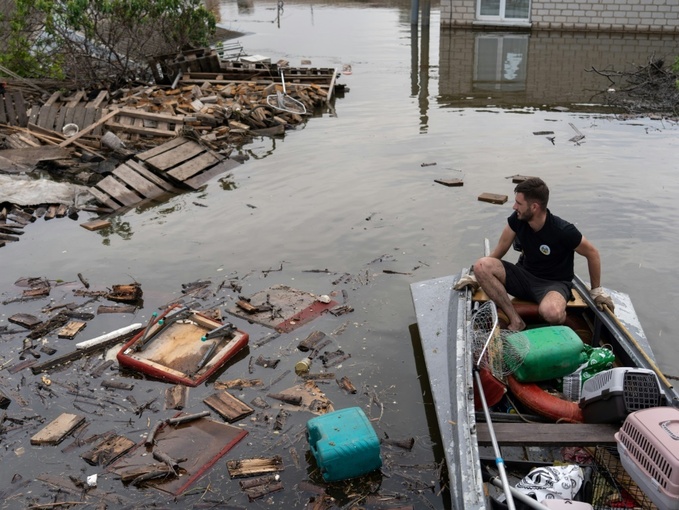The destruction of the Kakhovka dam in southern Ukraine is wreaking havoc on the environment with severe human consequences, experts say.
The dam was breached on Tuesday, forcing thousands to flee their homes as water surged into the Dnipro River, flooding dozens of villages and parts of the regional capital Kherson while sparking fears of a humanitarian disaster.
The environmental impact is grave, NGOs told AFP.
- 'Ecocide' –
Ukraine and Russia have accused each other of causing the breach.
Ukrainian President Volodymyr Zelensky said it was a "crime against humanity and an ecocide".
He called it "one of the most significant environmental catastrophes in Europe in recent decades" and accused Russia of detonating an "environmental bomb of mass destruction".
Earlier this year, Brussels paved the way for the recognition of "ecocide" in EU law.
- Risk to plants and animals -
After the release of 18 billion tonnes of water held back by the dam, ecosystems will suffer serious harm along the Dnipro, Europe's fourth-longest river.
The damage could extend to coastal areas of the Black Sea that might be temporarily desalinated in some areas, according to the Ukrainian NGO Ecoaction.
It warned of a potential "mass mortality" threatening fish, molluscs, crustaceans, microorganisms, aquatic plants and rodents. Some of these species are found only in the region and are already at risk.
The NGO also warned of a "deterioration in water quality due to the decomposition of dead organisms".
The Ukrainian Nature Conservation Group said the consequences for wildlife would be felt over an area of at least 5,000 square kilometres (almost 2,000 square miles).
"Some species may have suffered a greater blow in one day on June 6 than in the last 100 years," it said.
The group added that it could take a decade to make up for the impact on fish, and that some nesting birds would disappear from the area.
Domestic and captive animals are also in danger, according to the International Fund for Animal Welfare (IFAW).
"Shelters are already overwhelmed by requests for rescue," said Natalia Gozak, an IFAW official in Ukraine.
A zoo in flood-hit Nova Kakhovka has been completely inundated, Gozak said: "All the animals, except the swans, are dead."
Upstream, vegetation "will die as a result of drainage... while downstream areas will be flooded, including steppe and forest zones not adapted to flooding, leading to their waterlogging and destruction", Ecoaction warned.
Several of Ukraine's national parks, including the UNESCO-listed Black Sea Biosphere Reserve, are also directly threatened.
- Pollution -
Widespread pollution from the dam's breach is expected due to rubbish, agrochemicals, hazardous materials and the damage to wastewater treatment and sewage systems.
Ukrainian officials said Tuesday that 150 tonnes of engine oil had spilled into the Dnipro, with the risk of a further leakage of more than 300 tonnes. Zelensky said it posed "a threat to the unique flora and fauna."
Pollution is expected to reach the Black Sea and could affect organisms from plankton to dolphins.
- Flooding and water shortages -
Over 40,000 people are in danger of being flooded, Ukraine's prosecutor general Andriy Kostin warned Tuesday as he announced mass evacuations.
The damage is also likely to affect agriculture and livestock farming, sparking fears of a humanitarian disaster. Ukraine is one of the world's main suppliers of grain.
The Kakhovka dam provided drinking water and irrigation for southern Ukraine, one of the driest parts of the country, and its destruction represents a major risk to the water supply of millions of people.
IFAW said the water shortage could leave some areas parched.
"The rotting biomass of aquatic flora and fauna will be transformed into arid land, or even desert, in the coming months," Gozak said.
The damage will alter microclimates and temperatures, Gozak added, and could spark a wave of migration to other regions of Ukraine and Europe.
dep-jmi/uh/pa/lcm/js
© Agence France-Presse
Your content is great. However, if any of the content contained herein violates any rights of yours, including those of copyright, please contact us immediately by e-mail at media[@]kissrpr.com.
Source: Story.KISSPR.com

